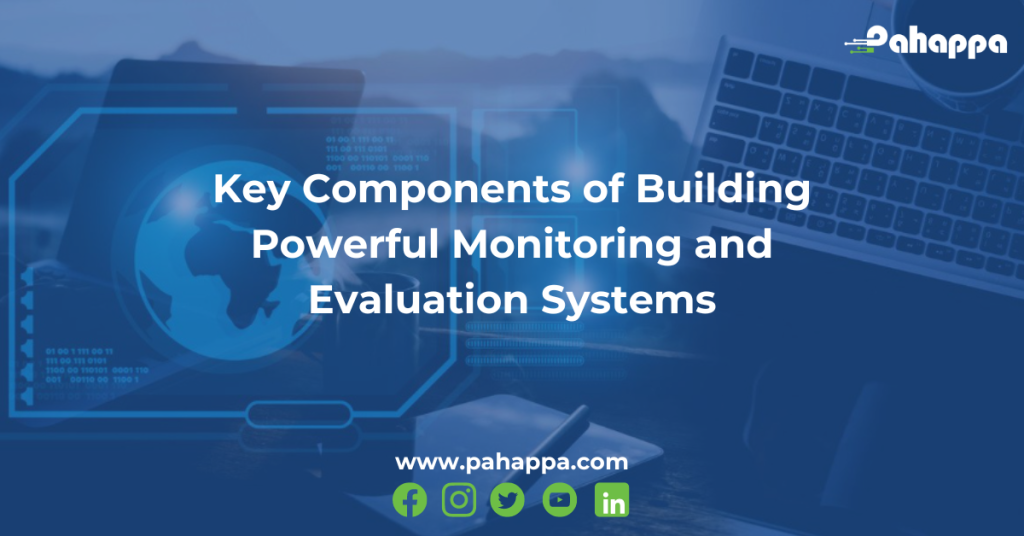Do you struggle to track the progress and impact of your projects? Imagine pouring time and resources into an initiative, but having no clear way to measure its success. This is where a well-designed Monitoring and Evaluation (M&E) system comes in. It’s like a roadmap that helps you navigate your projects, ensuring they deliver the desired results. This blog post dives into the essential components of an M&E system, providing a strong foundation for tracking your initiatives and maximizing their impact.
What is a Monitoring and Evaluation System?
An M&E system is a comprehensive toolbox filled with processes and tools. It allows you to continuously track your project’s progress, measure its impact, and use these insights to inform future decisions. In simpler terms, it helps you see if your project activities are on the right track, achieving the intended goals, and ultimately contributing to your organization’s overall objectives.
The Building Blocks of a Powerful M&E System
-
M&E Framework: This is the foundation of your system. It establishes clear goals (what you want to achieve), specific objectives (measurable steps to reach those goals), and indicators (specific variables to track progress). Think of it as a roadmap outlining your destination (goals) and the milestones (objectives) you need to reach along the way. Indicators act like road signs, helping you stay on track.
-
Indicators: These are the cornerstones of measurement within your M&E system. They should be SMART: Specific (clearly defined), Measurable (quantifiable data can be collected), Achievable (realistic and attainable), Relevant (directly linked to your objectives), and Time-bound (with a specific timeframe for measurement). Strong indicators ensure you are measuring the right things and getting meaningful data. For example, instead of a vague goal of “improve client satisfaction,” a SMART indicator could be “increase client satisfaction score by 10% within the next quarter.”
-
Data Collection Methods: This is how you gather the information needed to assess your indicators. Common methods include surveys (questionnaires for participants), interviews (in-depth conversations), focus groups (discussions with a small group), and data analysis of existing records (utilizing data you already have). Choosing the right method depends on your specific needs and resources.
-
Data Management and Analysis: Once you collect data, you need to organize and analyze it to extract valuable insights. Efficient data management systems ensure your information is accurate, accessible, and secure. Data analysis techniques, like calculating averages or percentages, help you understand what the data means and identify trends.
-
Reporting and Utilization: Clear and concise M&E reports are important for communicating your findings. These reports should showcase your project’s progress, highlight successes and challenges, and translate data into actionable recommendations. The ultimate goal is to use these insights to improve your programs and maximize their impact.
Building a Sustainable M&E System
A strong M&E system goes beyond just collecting data. Here are some additional considerations for long-term success:
-
Human Resources and Capacity Building: A skilled team is essential to manage and implement the M&E system effectively. This may involve training staff on data collection, analysis, and reporting techniques.
-
Communication and Advocacy: Stakeholders, including project beneficiaries, funders, and decision-makers, need to understand the value of M&E and how the findings are used. Clear communication fosters buy-in and ensures everyone is on the same page.
-
Sustainability and Integration: The M&E system should be seamlessly integrated into your organization’s processes. This ensures it’s used consistently and becomes a natural part of your project management cycle.
By implementing these key components, you can build a robust M&E system that empowers you to:
- Make data-driven decisions based on evidence, not assumptions.
- Improve the effectiveness and efficiency of your projects by identifying areas for improvement.
- Demonstrate the impact of your work to stakeholders, fostering trust and securing future funding.
- Promote accountability and transparency within your organization.
Conclusion
Ready to take your project monitoring and evaluation to the next level? Contant us today for free consultation and quote to implement a system tailored to your specific needs. An M&E system is an investment that pays off in the long run, ensuring your projects deliver lasting results and make a real difference.






